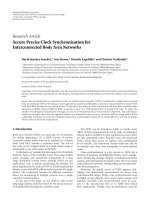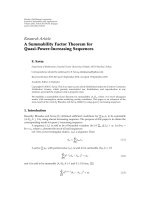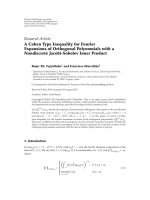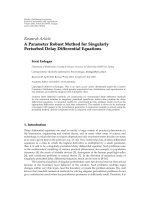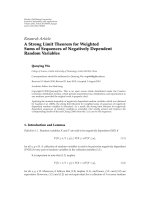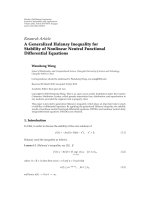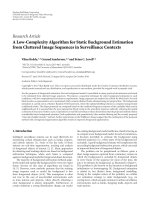Báo cáo hóa học: "Research Article A Cross-Layer Routing Design for Multi-Interface Wireless Mesh Networks" pptx
Bạn đang xem bản rút gọn của tài liệu. Xem và tải ngay bản đầy đủ của tài liệu tại đây (993.96 KB, 8 trang )
Hindawi Publishing Corporation
EURASIP Journal on Wireless Communications and Networking
Volume 2009, Article ID 208524, 8 pages
doi:10.1155/2009/208524
Research Article
A Cross-Layer Routing Design for Multi-Interface
Wireless Mesh Networks
Tzu-Chieh Tsai and Sung-Ta Tsai
Department of Computer Science, National Che ngchi University, Taipei, Taiwan
Correspondence should be addressed to Tzu-Chieh Tsai,
Received 15 April 2009; Accepted 7 August 2009
Recommended by Naveen Chilamkurti
In recent years, Wireless Mesh Networks (WMNs) technologies have received significant attentions. WMNs not only accede to
the advantages of ad hoc networks but also provide hierarchical multi-interface architecture. Transmission power control and
routing path selections are critical issues in the past researches of multihop networks. Variable transmission power levels lead
to different network connectivity and interference. Further, routing path selections among different radio interfaces will also
produce different intra-/interflow interference. These features tightly affect the network performance. Most of the related works
on the routing protocol design do not consider transmission power control and multi-interface environment simultaneously.
In this paper, we proposed a cross-layer routing protocol called M
2
iRi
2
which coordinates transmission power control and intra-
/interflow interference considerations as routing metrics. Each radio interface calculates the potential tolerable-added transmission
interference in the physical layer. When the route discovery starts, the M
2
iRi
2
will adopt the appropriate power level to evaluate
each interface quality along paths. The simulation results demonstrate that our design can enhance both network throughput and
end-to-end delay.
Copyright © 2009 T C. Tsai and S T. Tsai. This is an open access article distributed under the Creative Commons Attribution
License, which permits unrestricted use, distribution, and reproduction in any medium, provided the original work is properly
cited.
1. Introduction
Wireless Mesh Networks (WMNs) have the characterisitcs of
low deployment cost, easy maintenance, and reliable service
coverage technologies to form robustness networks. The
task group “s” (TGs) of IEEE 802.11 develops a flexible
and extensible standard for wireless mesh networks based
on the original IEEE 802.11. However, IEEE 802.11 TGs
adopts two main proposals—SEE-Mesh (Intel) and Wi-Mesh
(Nortel) intending to specify a framework for WLAN Mesh
networking [1]. In WMNs, nodes are comprised of mesh
routers and mesh clients [2]. Mesh routers form a wireless
backbone of WMNs, which provide multi-hop connectivities
between mesh clients and mesh gateways that have wired
connectivity with Internet (Figure 1).
WMNs are dynamically self-organized and self-
configured, with the nodes in the network automatically
establishing and maintaining mesh connectivity among
themselves and compatible with conventional Wi-Fi clients.
Multi-interface WMNs provide multiple radio interfaces of
a node that can improve the throughput capacity [3]. This
feature enables nodes to transmit and receive simultaneously,
hence nodes can use nonoverlapping channels to transmit
and receive at the same time via different interfaces. WMNs
technologies accede to the advantages of ad hoc networks.
Traditional ad hoc network routing protocols may not be
suitalbe for WMNs since they do not fully consider the
features of WMNs such as multi-interface. In IEEE 802.11s,
it presents the prototype of default path selection protocol-
HWMP (Hybrid Wireless Mesh Protocol) and routing
metric-airtime cost. The implementation details can be
based on user demands. Several routing protocol designs for
WMNs [4, 5] focus on single layer of network protocol stacks
and do not consider coordinating with different protocol
layers. Specifically, in the physical layer, the transmission
power level decides the signal strength and determines the
neighbor nodes which can hear the packet. This thus affects
the network layer to select the forwarding nodes at the
route discovery. The transmission power also causes the
interference that affect the link quality among nodes. The
2 EURASIP Journal on Wireless Communications and Networking
appropriate transmission power level selection can improve
network performance [6–8]. Traditional transmission power
control problems in wireless ad hoc networks mainly focus
on reducing energy consumption. Some researches address
power selection problems but still use minimum hop-count
as the routing metric. Power control indeed impacts multiple
network protocol layers. Transmission power control tightly
affects network performance [9]. The theoretical studies
[10] have demonstrated that transmission power control
can improve wireless network capacity. The result in [11]
presents that the need to design future protocols is based
on variable-range power control, not on common-range
transmission power control. The higher transmission power
increases network connectivity and gives lower end-to-
end delay in the low traffic load with slight interference.
However, the higher transmission power will create high
interference when concurrent transmissions in the vicinity
are increased. This will decrease the spatial reusability. In this
high loading case, using lower transmission power will result
in lower interference, and thus increase the throughput. The
motivation of our cross-layer routing protocol development
is inspired from the above features we observed.
We previously proposed the MiRii (Multi-Interface Rout-
ing with Intra/Inter-flow Interference) [5] routing protocol
that measures intra-/interflow interference and applies to
routing path selection in the network layer. The multi-
interface feature is utilized by considering the channel
diversity of the routing path. By contrast with AODV [12],
ETX [13], and WCETT [4] (will be introduced later in
Section 2.2), the simulation results demonstrate that our
MiRii routing protocol can improve packet delivery ratio
and decrease end-to-end delay. To further improve the
performance, the routing protocol has to work together
with the physical layer. In this paper, we propose our
cross-layer routing protocol, namely, M
2
iRi
2
(Multi-power,
Multi-interface Routing with Intra/Inter-flow Interference),
that incorporates MiRii routing protocol with perflow
transmission power control. M
2
iRi
2
routing protocol jointly
coordinates the transmission power at each trafficflowand
route selection among multi-interface nodes. The protocol
interplays between the network and the physical layers. It
aims to select appropriate transmission power to reduce the
noise interference more efficiently when the traffic loading in
the network is increased.
The rest of the paper is organized as follows. Section 2
reviews the past work related to link quality routing, load-
balancing routing, and the transmission power control on
the physical layer. Section 3 describes our cross-layer routing
protocol in detail. Section 4 presents the simulation result
and analysis. Finally, Section 5 concludes the paper with a
summary and proposes the future work.
2. Related Work
We first introduce some related work to our cross-layer
routing protocol M
2
iRi
2
, namely the transmission power
control and routing metrics in WMNs, including our
previous MiRii routing protocol.
Internet
Mesh
gateway
Mesh
routers
Mesh
clients
Mesh backbone/backhaul
Conventional
clients
Wired connection
Wireless connection
Figure 1: Wireless Mesh Networks.
2.1. Transmission Power Control. Previous transmission
power control schemes for ad hoc networks have focused on
throughput improvement or power consumption. We do not
consider the power consumption in our work becasue WMN
backbone does not have power consumption issues. In [10],
the author shows that reducing the transmission power can
increase the carrying capacity of the network. The work in
[11] concludes that variable-range transmission power can
improve the overall network performance. Some researches
address the power-controlled problem on the network layer
[6, 7]. The COMPOW protocol [6] relies on the DSDV
routing protocol to discover the smallest common power
level at which the entire network is still connected. However,
it suffers when some nodes can only use high power to be
connected. In [7], the proposed CLUSTERPOW protocol
performs the routing protocol several times with different
power levels at each run and independently builds a routing
table at each power level. A node consults the routing table
with the lowest power to forward packets to the next hop.
This consumes too much network resource.
Several researches [8, 14, 15] introduce the interference
tolerance in their transmission power control architecture.
The interference tolerance represents how much interference
a node can allow the potential transmission of its neighbors.
Nodes transmit the packets with the power level that does not
disturb the ongoing receptions of its neighbors. In [8], the
authors proposed a power controlled multiple access wireless
MAC protocol (PCMA) within the collision avoidance
framework. In PCMA, each receiver sends busy tone pulses
to announce its interference tolerance. If the trasmitter has
data to send to the receiver, it will determine its power
bound according to the interference tolerance declared by the
receiver’s busy tone. It then sends Request-Power-To-Send
(RPTS) with appropriate power level setting accordingly.
The receiver will calculate its tolerable power level and send
EURASIP Journal on Wireless Communications and Networking 3
acceptable-power-to-send (APTS) back to the sender. In
other words, the protocol design is based on CSMA/CA
and modifies the RTS/CTS to RPTS/APTS (Request-Power-
To-Send/Acceptable-Power-To-Send) to support potential
interfering transmissions to transmit concurrently rather
than to silence it. However, PCMA uses the additional
separate control channel to send the busy tone pulses.
PCDC (Power Controlled Dual Channel) [14] also uses dual
channels for data and control packets. A single channel
solution for transmission power control (POWMAC) is used
in [15]. In POWMAC, the interference tolerance is inserted
into the CTS packet and an additional control packet DTS
(Decide-To-Send) is used by transmitter to confirm the
transmission. Furthermore, the DTS is utilized to inform
the neighbors of transmitter about the power level that the
transmitter will use for its data transmission. The neighbors
of the transmitter can determine whether or not they can
receive the data packets form other nodes simultaneously
through DTS.
From the comparisons of [8, 14, 15], we finally adopt
the interference tolerance concept to be integrated into
our cross-layer routing protocol design. We will facilitate
concurrent interference-tolerable transmissions in the same
vicinity of the receiver to enhance the WMN backbone
capacity. Furthermore, we piggyback the interference toler-
ance information in probe packets which are integrated in
the network layer routing protocol. It is not using a separate
control channel to alert the neighboring nodes.
2.2. Routing Metrics in WMNs. Most of the routing protocols
use “hop count” as the routing metric. The minimum hop-
count routing is not suitable for wireless networks because
of dynamic wireless link quality characteristics. The work in
[4, 13] proposes new routing metrics considering the link
quality dynamics. MiRii proposed in [5] further considers
the intra-/interflow interferences in multi-interface routing
path selections.
Theworkin[13] proposed the concept of the expected
transmission count (ETX) as the routing metric. ETX is
calculated by measuring the delivery ratios for probe packets
in bidirectional transmissions of each link. It predicts the
number of data transmissions required to send a packet
and get a successful acknowledgment. Therefore, the ETX
accounts for interference among the successive links of a
path. Although ETX does well in single-radio wireless ad
hoc network, it does not perform well in multiradio and
multichannel wireless mesh networks. Reference [4] presents
a new routing metric for multiradio, multihop wireless mesh
networks, called WCETT (Weighted Cumulative Expected
Transmission Time). WCETT assigns weights to individual
links based on the Expected Transmission Time (ETT) of
a packet over the link. As a result, the WCETT of a route
with n hops can be the sum of the ETTs of all hops along
the path. Further, WCETT assumes that the network has a
total of k channels in an n-hop path. However, X
j
is the
sum of transmission time of hops that uses channel j along
the path. The total path throughput will be dominated by
the bottleneck channel, which has the highest X
j
.WCETT
takes both link quality (ETT) and channel diversity (X
j
) into
considerations. Thus, WCETT combines these two features
by taking their weighted average as follows:
WCETT
=
1 − β
∗
n
i=1
ETT
i
+ β ∗ max
1≤ j≤k
X
j
. (1)
In fact, the WCETT metric takes “intraflow” (means
the same flow, but between different hops) interference
into consideration, but does not capture “interflow” (means
between different neighboring flows) interference. In our
previous work [5], we propose a new routing metric, MiRii,
that considers both intraflow and interflow interference
in the multi-interface WMNs. In order to capture the
interflow interference, we calculate the nodal activity and
intertraffic flow interference. We introduce Little’s Result
into the routing metric design that makes the interflow
interference unit cost compatible with WCETT. To this end,
we assume node k and node k’s neighboring nodes as a
closed system and the Activity Time (AT) of node k is shown
in (2). Also, N
k
and λ
k
are the average queue length and
average packet receiving rate of node k,respectively.The
sum of average queue length of k’s neighboring nodes is
the second parameter of numerator, and the sum of average
packet receiving rate of k’s neighboring nodes is the second
parameter of denominator in (2). The Activity Time (AT
k
)
regarding to k is the total average queue length divided by
total average packet receiving rate of the system:
AT
k
=
N
k
+
m
nb
=1
N
k
nb
λ
k
+
m
nb=1
λ
k
nb
. (2)
Therefore, by combining both intraflow and interflow inter-
ferences, the MiRii routing cost is defined as (3)
MiRii
=α
n
i=1
ETT
i
+β ∗ max
1≤ j≤k
chanETT
j
+γ
k∈path & k
/
= src,dst
AT
k
,
(3)
where α, β,andγ are the constant weights subject to α +
β + γ
= 1. Also,
ETT
i
means the total link quality con-
siderations and end-to-end delay over an n-hops path. The
chanETT
i
is the sum of transmission times of hops using
channel j, and represents the channel-diversity in multiradio
WMNs. Finally,
AT
k
is the interflow interference, and
represents the load-balanced routing cost.
3. Cross-Layer Routing Protocol Design
In the WMNs, the traffic loading changes dynamically due
to leaving or entering the network of traffic flows. From the
above observation, when the traffic loading is low, the traffic
flows should select the higher transmission power to enhance
the throughput and reduce delay. As the traffic loading
is increased, the high transmission power imposes more
interference that may disturb the ongoing transmission. The
new traffic flow needs to choose the lower power level
to transmit the data to alleviate interference. Further, the
packet transmission at each hop on the routing path suffers
4 EURASIP Journal on Wireless Communications and Networking
Network layer
Link quality measurement
iTolerance info exchange
MiRii routing
protocol
TxPower level selection
iTolerance calculation
Physical layer
Figure 2: The cross-layer routing protocol architecture.
propagation, handling, and queuing delays. When the traffic
loading is low, the queuing day may be insignificant. It
is better to use high transmission power to reduce hop
count and also reduce the handling delay. However, under
high traffic loading, the low transmission power reduces
the queuing delay because the queue length will grow due
to more neighbors’ interference or collisions. Therefore,
it is a good policy that we should adapt the appropriate
transmission power level according to the surrounding
interference constraints. This is one of the basic motivations
of our work.
3.1. Overv iew of Protocol. The scheme of the proposed
M
2
iRi
2
cross-layer routing protocol is shown in Figure 2.
The routing protocol is based on AODV [12]. We modify
it to support MiRii routing metric and transmission power
level selection on a perflow basis. The network layer coor-
dinates with the physical layer to choose the appropriate
transmission power level and to find a routing path with
better link quality. The proposed M
2
iRi
2
routing protocol is
operated among mesh routers. The mesh clients can access
the network by directly connecting to mesh routers. The
protocol does not consider dynamic channel assignment
for simplicity at this point. In the physical layer of the
model, there are several discrete transmission power levels
for each NIC (network interface card). The function of
“iTolerance Calculation” calculates the interference tolerance
of each ongoing receiving NIC at the node. The “Link Quality
Measurement” function measures the ETT and AT that are
used in the MiRii routing protocol. All the measurement and
information exchanges are through probe packets that are
broadcasted proactively by each NIC.
3.2. iTolerance Calculation. Suppose that a packet transmis-
sion from node i to node j is a successful reception if the
received SINR (Signal-to-Interference Noise Ratio) is above
a certain threshold:
SINR
i
=
P
i
G
ij
l
/
= i
P
l
G
lj
+ N
j
≥ SINR Threshold,
(4)
P
i
means the transmit power for node i and P
i
G
ij
is the
received power at node j,whereG
ij
is the propagation gain
for the direct transmission from node i to j. Also, N
j
is
the thermal noise at node j,and
l
/
= i
P
l
G
lj
is the sum of
interferences that transmit concurrently with node i.
However, iTolerance is defined as the interference toler-
ance that a receiver node can tolerate a new joining neigh-
boring interference without destroying its existing ongoing
receptions. So, the radio interface at node j, regarding to the
flow from node i, can allow its iTolerance as follows:
iTolerance
j
=
P
i
G
ij
SINR Threshold
−
⎛
⎝
l
/
= i
P
l
G
lj
+ N
j
⎞
⎠
. (5)
In the protocol design, we measure the actual propagation
gain based on the received power of the probe packet at the
receiver side. Nodes can locally measure their interference
tolerance according to the sum of the strengths of all the
interfering signals. Each radio interface on the node will
advertise its interference tolerance to its one hop neighbors.
In the network layer, each node updates its neighbors’
iTolerance through the probe packet. When the route
discovery starts, the node looks up its neighbors’ iTolerance
and chooses the appropriate TxPower (transmission power)
level to send RREQ or forward RREQ messages. From the
(6), the routing protocol will select the highest TxPower
when the iTolerance constraints can be satisfied:
max
TxPower level | TxPower level
≤ min
neighbor l
iTolerance
l
G
il
.
(6)
We also apply for the MiRii routing metric which is
referred in (3)inourM
2
iRi
2
.Hence,eachtraffic flow select
the appropriate transmission power to send its route request
messages and use the MiRii routing metric to choose a
routing path that has the smallest MiRii cost. In M
2
iRi
2
,
we use the probe packet to measure the link quality and
piggyback the iTolerance information with the neighbors.
3.3. Perflow-Based Transmission Power Control and Routing.
The original AODV is a destination-based routing protocol,
and suffers the route flapping problem. For example, we
assume that both flows 1 and 2 route through node A to
the same destination node B. Some time later, the route
entry of A’s routing table to destination B changes for
somereason.Itwillaffect both flow 1 and switch their
routing paths simultaneously. The destination-based routing
protocol cannot balance the traffic loading. In this case,
perflow routing will be a good choice to solve the problem.
In order to achieve the idea of perflow-based transmission
power control and routing, the routing table should keep
records for not only the destination (Dst) of the route but
also flow id (Fid) of pertraffic flow. Further, the routing table
records each traffic flows TxPower level that it uses to reach
next hop. Hence, each interface on the node looks up the
routing table according to the parameters (Dst, Fid) and
EURASIP Journal on Wireless Communications and Networking 5
Type J R G D U
Reserved
Hop count
RREQ ID
Destination IP address
Destination sequence number
Originator IP address
Originator sequence number
Σ ETT
link
Σ chanETT
link
Σ AT
node
Fid
TxPower
Figure 3:TheformatofRREQpacket.
adjusts the transmission power level for this trafficflowto
forward to the next hop.
The data transmission is based on CSMA/CA and the
iTolerance value at the radio interface changes dynamically.
So, we still transmit the data packet by using the lowest
transmission power level even if there is no power level
satisfied the iTolerance constraints. Notice that here, for
simplicity and fair performance comparisons later, we do
not apply call admission control to reject any new flows.
The Route Request (RREQ) packet format is illustrated in
Figure 3. The fields of (
ETT
link
,
chanETT
link
,
AT
node
)
are used to calculate the MiRii value. The fields of (Fid,
TxPower) are utilized to achieve the per-flow transmission
power control.
In reality, the channel fading and interference change
dynamically. It is difficult to calculate exact tolerable power
level or link quality. There are some papers [16, 17] that
proposed different approaches to deal with these. However,
in concern with complexity of the algortihm, we are not
dealing with the fading channel problem here. Instead, in
our design, we use the “moving average” estimation to
find the path in the sense of “statistically approximation”.
Thus, it may combat the slow fading but not fast fading
channels. Our proposed M
2
iRi
2
can find the path with
considering both existing and tolerable adding intereference.
In this way, the throughput is increased with reducing the
failed transmissions due to suffering too much intereference.
Therefore, energy consumption from the system view is
reduced, and efficiency is increased.
4. Simulation Results and Analysis
In this section, we evaluate the throughput and delay for
M
2
iRi
2
using NS-2 and contrast it with the flow-based
MiRii and AODV routing protocol. The radio propagation
model adopts Two-Ray Ground model in NS-2. Each node is
equipped with two NICs. The off-the-shelf Cisco Aironet 350
series client adapters or access points allow different transmit
power setting for one of 1, 5, 20, 30, 50, and 100 mW. We
adopt the 30 mW and 100 mW in our NS-2 simulation. The
SINR threshold is setting to 6.02 dB and the noise floor
at each node is
−120 dBm. The traffic flow type is CBR
012 34
567 89
Flow1 Flow2
Flow3 Flow4
Figure 4: A simple network topology.
Table 1: Delay-Throughput with different power levels.
Numberofflows 1234
MiRii-30 mW delay (ms) 14.0 37.9 102.3 157.7
MiRii-30 mW throughput (Kbps) 511.1 884.7 1119 1284
MiRii-100 mW delay (ms) 11.8 16.8 141.5 210.6
MiRii-100 mW throughput (Kbps) 510.2 1004 1057 931
(Constant Bit Rate) during the ON period of an equally ON-
OFF model and the packet sizes are 1000 Bytes.
We first look at a simple topology (see Figure 4)which
clearly demonstrates the benefits of using the appropriate
transmission power level at different interference environ-
ments. The flow-based MiRii routing protocol is introduced
to evaluate these two cases of power levels. The dash
line in 4 denotes the connectivity using 30 mW power,
while the communication range is double farther if using
100 mW power. Tabl e 1 shows the throughput and end-to-
end delay with different traffic flow numbers. Each traffic
flow transmits with data rate 512 KBits/s. “MiRii-30 mW”
indicates that we fix transmission power at 30 mW in the
entire network. The average end-to-end delay is defined as
the time of packet from leaving the source to successful
receiving at the destination. It includes the buffering time
before the routing path discovery, the queuing time, the
delay of retransmission at MAC layer, and propagation
delay. When the number of traffic flow is one, the traffic
loading is low and interference is slight. We can utilize high
transmission power level (100 mW) to reduce end-to-end
delay since it can travel through small hop counts. When the
numbers of flows are increased, the interference among radio
interfaces is increased. MiRii-30 mW can perform well since
radio interfaces with lower transmission power level reduce
the interference generating to its neighbors. The MiRii-
30 mW has lower end-to-end delay and higher throughput
than MiRii-100 mW.
Now we consider a 4
× 4uniformtopologyina
500 m
× 500 m region. Each node locates 80 meters apart.
In Figure 5, the light color (red) bars represent the high
traffic loading with data rate 1 Mbits/s and the dark color
(blue) bars represent the low traffic loading with data rate
512 Kbits/s. We consider the traffic flows in the WMNs
randomly start and terminate. We let the CBR trafficflow
randomly on/off but keep the number of active flows in
the network to be five in average. The numbers of traffic
flows and traffic pattern are the same in both cases. Figure 5
shows that all the routing protocol can operate well in the
low traffic loading. Because the trafficflowsarerandomly
6 EURASIP Journal on Wireless Communications and Networking
0
500
1000
1500
2000
2500
3000
3500
4000
4500
5000
Throughput (Kbps)
MiRi
Mirii
30 mW
Mirii
100 mW
AODV
30 mW
AODV
100 mW
CBR: 512 Kbits/s
CBR: 1 Mbits/s
Tr affic type: CBR, average flow number:5 flows
Figure 5: Throughput of different traffic load in a uniform network
topology.
0
50
100
150
200
250
300
350
Throughput (Kbps)
MiRi
Mirii
30 mW
Mirii
100 mW
AODV
30 mW
AODV
100 mW
CBR: 512 Kbits/s
CBR: 1 Mbits/s
Tr affic type: CBR,average flow number: 5 flows
Figure 6: Average end-to-end delay of different trafficloadina
uniform network topology.
on/off and choose the source-destination pair randomly.
The destination-based routing protocol also increases RREQ
broadcast times and increases the packets waiting in the
buffer before the routing path establishment. The flow-based
routing protocol has the delay better than destination-based
routing protocol. Even if the flow-based routing protocol
needs to broadcast RREQ packets for each flow, it can
discover better routing path than destination-based routing
protocol. When the data rate increases to 1 Mbits/s, the
transmission power fixed at 30 mW has throughput better
than 100 mW, and the end-to-end delay has the same result.
In this case, M
2
iRi
2
have the throughput similar to MiRii-
30 mW, and improve the throughput 13% contrasting with
MiRii-100 mW. In Figure 6, the results of average end-to-end
delay of M
2
iRi
2
are decreased by 30% and 48% contrasting
with MiRii-30 mW and MiRii-100 mW, respectively.
We next simulate our protocol on a topology that nodes
are randomly placed in a 500 m
× 500 m area (Figure 7). The
simulation parameters are the same as the uniform topology.
The throughputs are almost similar in these routing pro-
tocols at low traffic loading as we observe in the uniform
topology case. However, from Figure 8, the throughput of
M
2
iRi
2
is better than MiRii-30 mW and MiRii-100 mW
1
2
3
4
5
6
7
8
9
10
11
12
13
14
150
Figure 7: A random network topology.
0
1000
2000
3000
4000
5000
Throughput (Kbps)
MiRi
Mirii
30 mW
Mirii
100 mW
AODV
30 mW
AODV
100 mW
CBR: 512 Kbits/s
1 Mbits/s
Tr affic type: CBR, average flow number: 5 flows
Figure 8: Throughput of different traffic load in a random network
topology.
about 7% and 14% at high data rate. Figure 9 shows the
average end-to-end delay in the high and low data rate. The
delay of M
2
iRi
2
is further lower than MiRii-100 mW and is
better than MiRii-30 mW about 28% at high trafficdatarate.
The simulation results indicate that our proposed cross-layer
routing protocol utilizes the advantages of different power
levels in different network environments and performs well
by controlling the transmit power efficiently for perflow per
hop transmission.
Finally, we simulate a WMN with gateways, we choose
two nodes in Figure 7 to play the roles of mesh gateways. The
transmissions send the data packets to mesh gateways instead
of random Source-Destination pairs. The trafficpatterns
tightly affect the performance of the routing protocol.
Figures 10 and 11 show the simulation results in this case.
We observe that M
2
iRi
2
still has better throughput and end-
to-end delay than MiRii-30 mW and MiRii-100 mW when
the traffic data rate is 1 Mbits/s. All the routing protocols
EURASIP Journal on Wireless Communications and Networking 7
0
50
100
150
200
250
300
350
Average end-to-end delay (msec)
MiRi
Mirii
30 mW
Mirii
100 mW
AODV
30 mW
AODV
100 mW
CBR: 512 Kbits/s
CBR: 1 Mbits/s
Tr affic type: CBR, average flow number: 5 flows
Figure 9: Average end-to-end delay of different trafficloadina
random network topology.
0
1000
2000
3000
4000
5000
Throughput (Kbps)
MiRi
Mirii
30 mW
Mirii
100 mW
AODV
30 mW
AODV
100 mW
CBR: 512 Kbits/s
1 Mbits/s
Tr affic type: CBR, average flow number: 5 flows
Figure 10: Throughput of different trafficloadinarandom
network topology with gateway.
0
20
40
60
80
100
Average end-to-end delay (msec)
MiRi
Mirii
30 mW
Mirii
100 mW
AODV
30 mW
AODV
100 mW
CBR: 512 Kbits/s
CBR: 1 Mbits/s
Tr affic type: CBR, average flow number: 5 flows
Figure 11: Average end-to-end delay of different tra0-40pt
also operate well when the flow data rate is 512 Kbits/s. The
destination-based AODV routing protocol might have the
lower end-to-end delay depending on whether the traffic
flows have the same destination (gateway) or not, which will
reduce the route discovery time. The results also indicate that
our M
2
iRi
2
routing protocol operates well when the traffic
are all going towards gateways in the WMN.
5. Conclusion and Future Work
In the paper, we proposed M
2
iRi
2
routing protocol for
multi-interface WMNs. The main purpose is to coordinate
the physical layer and the network layer for a cross-layer
routing protocol development. Previous researches show that
variable transmit power level control can improve network
performance but they still use minimum hop counts as the
routing metric. We introduce the iTolerance to constrain
the transmit power level and incorporate it to the route
discovery. The MiRii routing metric is utilized to evaluate
the routing path with consideration of both intraflow and
interflow interferences. Furthermore, the power control is
designed on perflow, perhop basis. We thoroughly observe
the performance of M
2
iRi
2
at different traffic loadings.
When the traffic loading is high, the newly trafficflow
chooses the appropriate transmission power level along less
interference path to transmit the data packets in order not to
create intolerable interference to the existing transmissions.
Through the simulation results, we have demonstrated that
our M
2
iRi
2
routing protocol can enhance both network
throughput and end-to-end delay.
In the current version of M
2
iRi
2
routing protocol, the
traffic flow selects the lowest power level even if it would
violate the interference tolerance constraint. In the future,
we may incorporate M
2
iRi
2
with the traffic flow admission
control and extends the M
2
iRi
2
to more stability and even
better performance.
Acknowledgment
This work is granted by NSC-97-2221-E-004-004-MY2.
References
[1] H. Aoki, N. Chari, L. Chu, et al., “802.11 TGs simple efficient
extensible mesh (SEE-Mesh) proposal,” IEEE802.11 document
05/0562r0, 2005.
[2]I.F.AkyildizandX.Wang,“Asurveyonwirelessmesh
networks,” IEEE Communications Magazine,vol.43,no.9,pp.
22–30, 2005.
[3] A. Adya, P. Bahl, J. Padhye, A. Wolman, and L. Zhou, “A multi-
radio unification protocol for IEEE 802.11 wireless networks,”
in Proceedings of the 1st IEEE International Conference on
Broadband Networks (BroadNets ’04), pp. 344–354, October
2004.
[4] J. Padhye, R. Draves, and B. Zill, “Routing in multi-radio,
multi-hop wireless mesh networks,” in Proceedings of the 10th
Annual International Conference on Mobile Computing and
Networking (MOBICOM ’04), pp. 114–128, Philadelphia, Pa,
USA, 2004.
8 EURASIP Journal on Wireless Communications and Networking
[5] T C. Tsai and T F. Liu, “Multi-interface routing with
intra/inter-flow interference (MiRii) considerations in wire-
less mesh networks,” in Proceedings of the 3rd Asia-Pacific
Symposium on Queueing Theory and Network Applications,
2008.
[6] S. Narayanaswamy, V. Kawadia, R. S. Sreenivas, and P. R.
Kumar, “Power control in ad-hoc networks: theory, archi-
tecture, algorithm and implementation of the COMPOW
protocol,” in Proceedings of the European Wireless Conference
(EW ’02), 2002.
[7] V. Kawadia and P. R. Kumar, “Principles and protocols for
power control in wireless ad hoc networks,” IEEE Journal on
Selected Areas in Communications, vol. 23, no. 1, pp. 76–88,
2005.
[8]J.P.Monks,V.Bharghavan,andW.W.Hwu,“Apowercon-
trolled multiple access protocol for wireless packet networks,”
in Proceedings of the 20th Annual Joint Conference on the IEEE
Computer and Communications Societies (INFOCOM ’01), vol.
1, pp. 219–228, 2001.
[9] M. Krunz, A. Muqattash, and S J. Lee, “Transmission power
control in wireless ad hoc networks: challenges, solutions, and
open issues,” IEEE Network, vol. 18, no. 5, pp. 8–14, 2004.
[10] P. Gupta and P. R. Kumar, “The capacity of wireless networks,”
IEEE Transactions on Information Theory,vol.46,no.2,pp.
388–404, 2000.
[11] J. Gomex and A. T. Campbell, “Variable-range transmission
power control in wireless ad hoc networks,” IEEE Transactions
on Mobile Computing, vol. 6, no. 1, pp. 87–99, 2007.
[12] C. Perkins, E. Belding-Royer, and S. Das, “Ad hoc on-demand
distance vector (AODV) routing,” IETF RFC 3561, 2003.
[13] D. S. J. de Couto, D. Aguayo, J. Bicket, and R. Morris, “A high-
throughput path metric for multi-hop wireless routing,” in
Proceedings of the Annual International Conference on Mobile
Computing and Networking (MOBICOM ’03), pp. 134–146,
San Diego, Calif, USA, 2003.
[14] A. Muqattash and M. Krunz, “Power controlled dual chan-
nel (PCDC) medium access protocol for wireless ad hoc
networks,” in Proceedings of the Annual Joint Conference on
the IEEE Computer and Communications Societies (INFO-
COM ’03), pp. 470–480, 2003.
[15] A. Muqattash and M. Krunz, “POWMAC: a single-channel
power-control protocol for throughput enhancement in wire-
less ad hoc networks,” IEEE Journal on Selected Areas in
Communications, vol. 23, no. 5, pp. 1067–1084, 2005.
[16] L. Xiao, M. Johansson, and S. P. Boyd, “Simultaneous
routing and resurce allocation via dual decomposition,” IEEE
Transactions on Communications, vol. 52, no. 7, pp. 1136–
1144, 2004.
[17] M. P. Anastasopoulos, A. D. Panagopoulos, and P. G. Cottis,
“A distributed routing protocol for providing QoS in wireless
mesh networks operating above 10 GHz,” Wireless Communi-
cations and Mobile Computing, vol. 8, no. 10, pp. 1233–1245,
2008.
